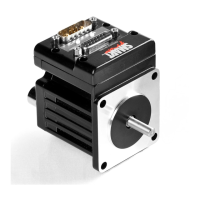Moog Animatics SmartMotor™ Developer's Guide,Rev. L
Page 148 of 909
winders.
l This direction is indicated by Status Word 7, Bit 13.
l This state is not reset by an X or an OFF.
arg1=0: (Power-up default value) Initially traverse toward higher bound
when G is issued.
arg1=1: Initially traverse toward lower bound when G is issued.
arg2 Special bits:
arg2=1: The RPC(2) frame of reference is updated with shaft motion
when the servo is off (OFF, MTB, MT). This is a special setting to ensure
backward compatibility with existing applications that may use the RPC
(2) frame of reference.
arg2=0: (Power-up default value) The RPC(2) frame of reference is
frozen when the servo is off (through OFF, MTB, MT).
MFL(distance[,m/s])
Ramp at the lower end of traverse; designate master or slave
distance
Specifies the ramp distance at the lower end of the traverse. Distance
range: 0 to 2147483647
[,m/s] 0=master, 1=slave; distance range: 0 to 2147483647
MFH(distance[,m/s])
Ramp at the higher end of traverse; designate master or slave
distance
Specifies the ramp distance at the higher end of the traverse. Distance
range: 0 to 2147483647
[,m/s] 0=master, 1=slave; distance range: 0 to 2147483647
ECS(counts)
Encoder count shift — immediately compensates for variation in material width
counts Specifies the counts to be added to (or subtracted from) incoming
master counts as if they had an immediate change in value. For
example, if the external encoder count is 4000, and ECS(1234) is
issued, the count would immediately shift to 5234. Note that when the
MFMUL:MFDIV ratio is other than 1:1, the ratio is multiplied by the ECS
value.
CAUTION: Large values may cause jerks in motion or following errors.
The ECS command is dynamic and immediate (not buffered), and it does not require a G
command. Further, it works on top of any gearing or camming mode.
Part 1: Programming: MFL(distance[,m/s])

